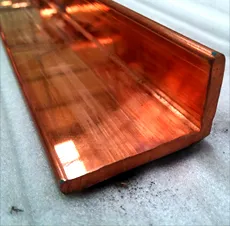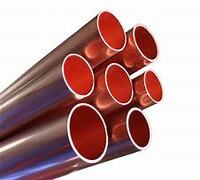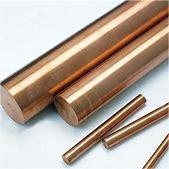1. Introduction
Just 24 hours ago, the London Metal Exchange reported a 3.2% spike in copper prices—triggered by supply chain hiccups in Chile and renewed green energy infrastructure spending in the EU. Translation? Your copper rod just got pricier, and your scrap-stripping side hustle might be more lucrative than your day job. But before you melt down grandma’s old wiring or order 500 meters of copper strip near me, let’s untangle the copper jungle.

Copper isn’t just one thing. It’s rods, strips, pipes, bars, ingots, and even snail-repelling tape (yes, really). This article cuts through the noise to compare the most commonly confused copper forms—especially copper rod variants—and help you pick the right one without accidentally buying a brazing rod when you needed an earthing rod.
2. Copper Rod: Not All Rods Are Created Equal
When people say ‘copper rod,’ they might mean anything from a solid round bar used in electrical busbars to a slender welding filler. Let’s sort this out before your project turns into a conductive comedy of errors.
- Rod copper used in electrical applications is typically high-purity electrolytic tough pitch (ETP) copper, often sold as copper round bar or round bar copper.
- Copper earth rod, earthing rod copper, and ground rod copper are designed for grounding systems. But here’s the twist: many aren’t solid copper at all.
Enter copper bonded earthing rod and copper clad ground rod. These are steel cores coated with a layer of copper—either through molecular bonding (copper bonded steel) or electroplating (copper clad steel earth rod). They’re cheaper than solid copper rods and nearly as effective for earthing, which explains why copper bonded ground rod dominates utility-scale installations.
Meanwhile, copper brazing rod and copper welding rod serve entirely different purposes. Copper to copper brazing rods are used to join copper parts without melting the base metal—ideal for HVAC or plumbing. Copper rod for welding, however, is rare; pure copper doesn’t weld easily. Most ‘copper welding rod’ products are actually copper alloys like ERCuSi-A. And no, copper to copper welding rod isn’t a magic wand—it requires precise heat control and often preheating.
Pro tip: If you’re comparing earthing rod price vs. copper rod price, remember—solid copper rods cost 3–5x more than copper bonded alternatives but last longer in corrosive soils.

3. Copper Strip: Thin, Flat, and Surprisingly Versatile
Don’t confuse copper rod with copper strip. These flat copper strips—sometimes called copper stip (a common typo) or copperstrip—are used in everything from busbars to snail deterrents (copper tape for snails exploits the mollusk’s aversion to copper ions).
Flat copper strip comes in rolls: copper strip roll, 1mm copper strip, thin copper strips, even nickel plated copper strip for enhanced corrosion resistance. Beryllium copper strip and copper beryllium strip offer high strength and conductivity—perfect for springs and connectors.
For earthing, copper strip for earthing (like the standard 25x3mm size) is preferred in substations. And yes, copper earth strip 25x3mm price fluctuates daily with the LME—so check before you buy in bulk.
Now, about stripping: if you’re salvaging copper strip wire or stripping copper wire for scrap, avoid the rookie mistake of burning insulation off. Burning copper wire for scrap releases toxic fumes and degrades the metal. The best way to strip copper wire? Use a manual or automatic wire stripper. The fast way to strip copper wire? Industrial cable strippers—but for home use, patience beats fire every time.
And no, stripping wire for recycling isn’t always worth it unless you’ve got industrial volumes. But if you do—stripping copper wire for scrap can net you serious cash when copper prices surge.
4. Copper Pipe: The AC Hero You Never Knew You Needed

While copper rod handles current and copper strip manages distribution, copper pipe moves fluids—especially refrigerant in air conditioning systems. Aircon copper pipe (or ac copper pipe) is typically soft-drawn, seamless tubing in sizes like 15mm copper pipe, 22mm copper tube, or 3/4 copper tubing.
Air conditioner copper pipe price varies by wall thickness (Type L vs. Type M) and market demand. Right now, with summer looming in the Northern Hemisphere, ac copper pipe price is climbing.
Bending copper pipe requires care—kinks ruin flow. And copper pipe soldering? It’s an art. Resoldering copper pipe without removing it is possible with the right flux and heat control, but messy joints cause leaks faster than you can say ‘flood insurance.’
Don’t mix copper pipe with PEX plumbing pipes unless you use proper copper pipe connectors. And never—ever—use aluminum fittings with copper lines. Galvanic corrosion will eat your system alive.
5. Conclusion
So, what’s the real difference? Copper rod conducts and grounds, copper strip distributes and deters (snails included), and copper pipe cools your house. Each has subtypes—solid vs. bonded, pure vs. alloyed, thick vs. thin—that drastically affect performance and price.
Before you buy, ask: Is this for conductivity, corrosion resistance, or mechanical strength? Check copper rod price vs. copper bonded alternatives. Verify copper strip price per kg. And for the love of Ohm, don’t burn your wire. With copper prices on the rise, doing it right pays off—literally.
Our Website founded on October 17, 2012, is a high-tech enterprise committed to the research and development, production, processing, sales and technical services of ceramic relative materials such as What’s. Our products includes but not limited to Boron Carbide Ceramic Products, Boron Nitride Ceramic Products, Silicon Carbide Ceramic Products, Silicon Nitride Ceramic Products, Zirconium Dioxide Ceramic Products, etc. If you are interested, please feel free to contact us.

